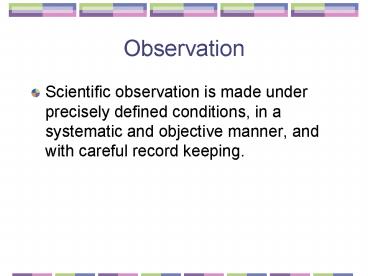Observation - PowerPoint PPT Presentation
1 / 17
Title:
Observation
Description:
Observing behavior in as many different ... More control/intervention than naturalistic observation, but less than in an experiment. ... Structured Observation ... – PowerPoint PPT presentation
Number of Views:1951
Avg rating:3.0/5.0
Title: Observation
1
Observation
- Scientific observation is made under precisely
defined conditions, in a systematic and objective
manner, and with careful record keeping.
2
Need to consider.
- WHO to observe
- WHEN to observe
- HOW to observe
- HOW to record data
3
WHO to observe?
- Results are only generalizable to participants,
times, settings, and conditions similar to those
in the study in which the observations were made. - Must have a representative sample.
4
WHEN to observe
- Time sampling
- Situation sampling
5
Time sampling
- Choose various time intervals for observations
- Random
- Systematic
- Or both
- When is time sampling NOT appropriate?
6
Situation Sampling
- Observing behavior in as many different locations
and under as many different circumstances as
possible.
7
HOW to observe
- Observation without intervention
- Observation with intervention
8
Observation without intervention
- Goal is to describe behavior as it normally
occurs and to examine relationships among
variables. - Reactivity
- Demand characteristics
9
Observation with intervention
- Most psychological research uses this type of
observation. - Three types well talk about
- Participant observation
- Structured observation
- Field experiments
10
Participant Observation
- Beneficial because it allows access to
places/situations that is usually not open to
scientific observation. - Pretending to be schizophrenic
- Pretending to be a black man
- Can also be problematic why?
- Disguised vs. Undisguised
11
Structured Observation
- More control/intervention than naturalistic
observation, but less than in an experiment. - The participant sets up a situation that can be
observed.
12
Pros and Cons of Structured Observation
- Can observe behavior under conditions
that are more natural than in the lab. - - Failing to follow the same procedures EACH
time can be problematic. - - Uncontrolled (or even unknown) variables can
interfere.
13
Field Experiments
- The observer manipulates one or more independent
variables. - This is the most extreme form of intervention in
observational methods.
14
HOW to record data
- Qualitative
- Narrative record
- Field notes
- Quantitative
- Check list yes or no
- Frequency of occurrence
- Ratings on a likert scale
- Electronic recording and tracking
15
Data
- Data reduction
- Coding
- Mean (central tendency)
- Standard deviation (variability)
- Frequency counts
16
What about reliability?
- Interobserver reliability the degree to which
two independent observers agree. - How do we get this number?
- Percentage agreement (Number of agreements /
Number of observations) X 100 - Correlate the two observers ratings
17
What about observer bias?
- Expectancy effects
- Ways to control observer bias
- Keep observes blind as to the hypotheses of the
experiment - Recognize that bias may be present































